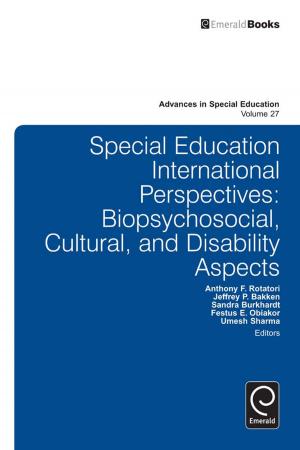Viewpoints on Interventions for Learners with Disabilities
Nonfiction, Reference & Language, Education & Teaching, Teaching, Teaching Methods, Educational Theory| Author: | ISBN: | 9781787432475 | |
| Publisher: | Emerald Publishing Limited | Publication: | May 18, 2018 |
| Imprint: | Emerald Publishing Limited | Language: | English |
| Author: | |
| ISBN: | 9781787432475 |
| Publisher: | Emerald Publishing Limited |
| Publication: | May 18, 2018 |
| Imprint: | Emerald Publishing Limited |
| Language: | English |
Interventions in special education are results of advocacy, legislation, litigation, research, and trends. Since interventions come in many forms, they represent multidimensional viewpoints and perspectives and need to be handled with professional care, integrity, fidelity. This book highlights the fact there are skill-sets needed to work with divergent disability categories. The chapters begin with introducing readers to contextual bases of interventions for learners with disabilities and end with futuristic perspectives that go beyond tradition. Other chapters focus on students with learning disabilities, emotional and behavioral disorders, and intellectual disabilities. Additional chapters focus on students who are deaf and hard of hearing, and students with visual impairments, autism, severe disabilities, traumatic brain injury, speech and language impairments, and physical and other health impairments.
This volume presents the voices of leaders in the field of special education and addresses critical issues related to identification, assessment, labeling, placement, and instruction. Furthermore, it responds to what makes special education “special.” Not only does this volume present historical contexts, it also authenticates the legitimacy of helping all learners to maximize their fullest potential, the real essence of special education. To a large extent, this book will be an excellent resource for undergraduate and graduate students, regular educators, special educators, educator preparation professionals, researchers, scholars, and practitioners.
Interventions in special education are results of advocacy, legislation, litigation, research, and trends. Since interventions come in many forms, they represent multidimensional viewpoints and perspectives and need to be handled with professional care, integrity, fidelity. This book highlights the fact there are skill-sets needed to work with divergent disability categories. The chapters begin with introducing readers to contextual bases of interventions for learners with disabilities and end with futuristic perspectives that go beyond tradition. Other chapters focus on students with learning disabilities, emotional and behavioral disorders, and intellectual disabilities. Additional chapters focus on students who are deaf and hard of hearing, and students with visual impairments, autism, severe disabilities, traumatic brain injury, speech and language impairments, and physical and other health impairments.
This volume presents the voices of leaders in the field of special education and addresses critical issues related to identification, assessment, labeling, placement, and instruction. Furthermore, it responds to what makes special education “special.” Not only does this volume present historical contexts, it also authenticates the legitimacy of helping all learners to maximize their fullest potential, the real essence of special education. To a large extent, this book will be an excellent resource for undergraduate and graduate students, regular educators, special educators, educator preparation professionals, researchers, scholars, and practitioners.















